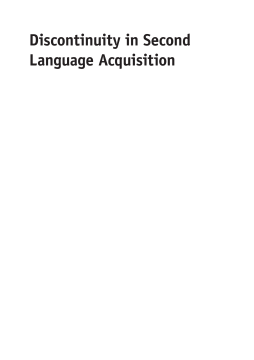
Additional Information
Book Details
Abstract
With a particular focus on the morphosyntactic features of second language, this book discusses the idea that language acquisition is a discontinuous and 'quantized' process and thus that some items might be learned twice, statistically and grammatically. It argues that the switch from one way of learning to another is statistically-driven and grammatically motivated. The volume brings together and discusses insights and evidence from learner corpora analysis and electrophysiological data in an attempt to provide the reader with a unified outlook and it suggests a new, developmentally-oriented interpretation of findings. The topics discussed will be of interest to researchers working in the field of psycho- and neurolinguistics and SLA.
The first quality distinguishing the Italian psycholinguist Stefano Rastelli’s book Discontinuity in Second Language Acquisition: The Switch between Statistical and Grammatical Learning (henceforth, Discontinuity) is its coherence as a single-author volume focused entirely on SLA, predominantly by adults. The second is the breadth and depth of Rastelli’s knowledge of current theory and research in linguistics, cognitive psychology, neurolinguistics, and SLA, and his ability to synthesize and integrate work from all four. The third is the originality of his perspective.
Michael H. Long, University of Maryland, US
Stefano Rastelli teaches Second Language Acquisition at the Universities of Pavia and Verona, Italy. He is an associate member of CAROLE (Center for Advanced Research and Outreach in Language Education), University of Greenwich. His research focuses on second language processing and syntactic theory and he has published numerous research articles in international journals.
Table of Contents
| Section Title | Page | Action | Price |
|---|---|---|---|
| Contents | v | ||
| 1 Second Language Acquisition Facit Saltus (‘Takes a Leap’) | 1 | ||
| 2 Discontinuity as Chunks Feedinto Grammar | 43 | ||
| 3 Discontinuity in the Maturing and in the Adapting Brain | 64 | ||
| 4 Discontinuity and the Neurocognition of Second Language | 96 | ||
| 5 Statistical Learning of a Second Language | 135 | ||
| 6 Parts of L2 Grammar That Resist Statistical Learning | 178 | ||
| Conclusions | 220 | ||
| References | 225 | ||
| Index | 251 |
